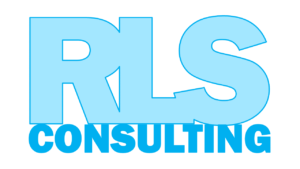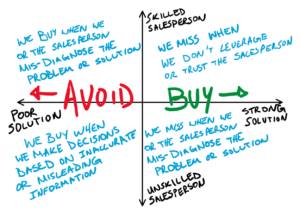The Buyer’s Challenge – Part 4
This article is related to a larger discussion about the “Buyer’s Challenge” and references topics introduced in the main article here: The Buyer’s Challenge
If you’re starting here, we are breaking down the challenges that keep buyers from getting to a strong solution, or that would help them avoid a poor solution, by looking at each of 4 different scenarios that can occur.
This article covers Part 4:
- A Poor Solution and a Salesperson with High Skillsets
Here, we have a skilled guide that can navigate the buyer through the process, but their solution isn’t going to cut it for the problem the buyer is experiencing.
So, assuming this salesperson has the best of intentions and that they would tell the client when it’s not the right fit, how does this still end up becoming a problem?
The buyer may have held back critical details.
At times, people may be afraid to share details in the discovery process in fear that it could be used later in a negotiation to push them into a solution they don’t want. This apprehension can cause them to withhold something that distorts the salesperson’s understanding of the situation and appropriate solutions. However, with both buyer and salesperson believing they’ve solved the issue, they go forward with the wrong solution.
The salesperson may not yet know that this is the wrong fit.
Sometimes companies can have misunderstandings between sales and delivery. It’s a tough reality that can play out for many well-intentioned businesses that are growing fast.
A salesperson may have great problem-solving skills, but not know the company is struggling to deliver on what they promise or there is some other confusion at play. It may take meeting more of the delivery and product teams to confirm that the solution will have the correct outcomes.
That unskilled salesperson and their poor solution came back to haunt us again.
It could even come about in a competitive deal where one of the other situations we discussed in the buyer’s challenge has occurred: where a salesperson with low skillsets was pushing the buyer into a sub-par product and now all of the other vendors are forced to do the same.
When we get mis-aligned proposals, it can help to go back and dig deeper into why there are major differences – especially in highly commoditized products or services that should be similar.
How I’ve personally seen this scenario play out:
I’ve had situations in the past as a salesperson where I’ve felt forced by the buyer to present a sub-par solution. In many cases, I’d typically do my best to avoid this and would rather walk away than play in this space.
In many cases, it seems to come up most often when there’s a major disconnect between the cost of the problem and the value of the solution.
It’s a lose-lose scenario. It creates bad clients and bad impressions of good solutions when you have the wrong tool for the job.
While most salespeople actively try to avoid this, sometimes it goes above our control, and we’re forced to play this losing game. Either because the client demands it or because our own leadership is so adamant about winning any deal possible that quantity trumps quality (which is a toxic path forward for all involved).
If you can’t overcome this through deeper education or resetting expectations, it can lead to the wrong solution being put in place.
Most recently, this came about when a prospect I was working with had talked to another vendor that was recommending an old and outdated approach. It was a great price (because it was a bad idea, frankly) and the decision makers on the buying side were more focused on a cheap solution than the right one.
We could do the same but had moved away from that option years ago and knew their experience was not going to be what they’d hoped.
Yeah, they’d save money implementing this, but it was going to reap its cost back in lost time, efficiency, and scalability.
We were eventually able to turn things around, but it could have gone sideways (for all of us involved) if we weren’t able to take extra time to educate the decision makers on the cost of making a poor decision here. The other vendor wasn’t very straightforward about the risks involved or the downsides to their solution.
In this particular instance, we’d put in a lot of time and were able to dodge a bullet. It could have very easily resulted in us providing a poor solution and creating a mess for implementation and future success. Or, the client would have ended up locked up in a contract with the other vendor doing just the same.
How do you avoid this?
Start by making sure the team you work with in discovery and solution development stages of the buying process fully understand what’s going on. Don’t be afraid to get deep into the problem analysis and lean into their expertise to help craft a solution.
When you have a competitive offer from another vendor that sounds too good to be true, take a deeper look at what’s going on and identify what’s different. You may need to ask some really specific questions to uncover what is causing such a major difference in recommended solutions.
Base your budget off of the value of fixing a costly problem and what you can accomplish in your future state. Sometimes the cheaper option has hidden costs that could result in a worse off situation.
And, when you think you have an idea of who you want to work with, consider pulling more people into the conversation on both sides of the deal. Involving your own stakeholders and decision makers, as well as leaders and delivery people on the other side, can help make sure everything is in alignment before starting a major project.
Continue Exploring The Buyer's Challenge
This article is just part of a larger discussion. Explore other scenarios and solutions as we continue exploring The Buyer’s Challenge:
The next posts in this series will drop over the week and the links above will be made active as it releases.
If you want to follow along, be sure to sign up for the newsletter through the form below.
Share

Ryan Smith
Ryan's experience across cybersecurity, sales, insurance, technology, education, and mathematics have helped him become a business-oriented problem solver that can simplify complex topics.
His eclectic and diverse background is now able to be leveraged by businesses that are interested in outside perspectives to help them overcome challenges.
Popular Posts

RLS Consulting Is (Re)Opening for Business!

Cybersecurity Begins at the Individual

The Buyer’s Challenge
Newsletter
Looking for Identity Theft Protection?
RLS Consulting is a proud distributor of defend-id ©.
Learn how protecting your employees from the perils of Identity Theft and Fraud can help your business security and overhead costs.
Want to sell defend-id through your insurance agency?
Learn More


